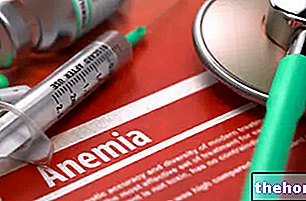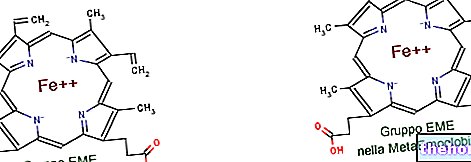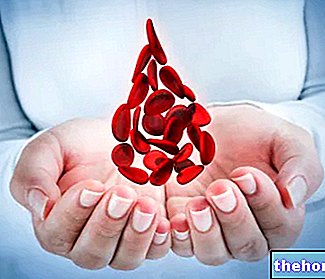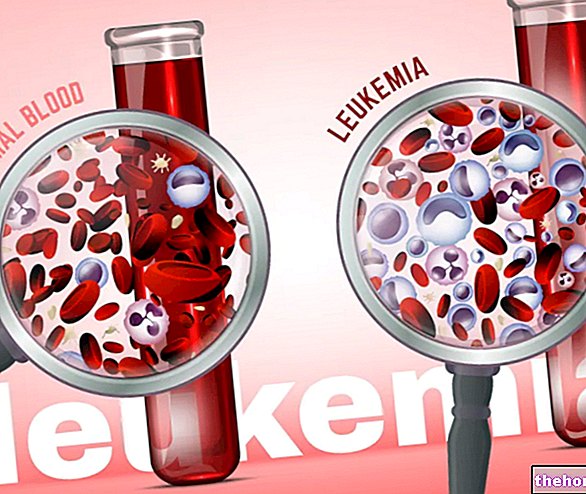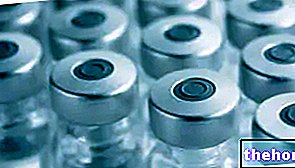Generality
An "embolism" is an interruption in blood flow, due to the presence of a mobile and insoluble foreign body, such as a blood clot, an air bubble, a lump of fat or amniotic fluid, a cholesterol crystal, a talcum granule etc.

Schedulable only after a "careful diagnosis, the treatment of an" embolism depends on at least three factors: the cause of the obstruction, the size of the emboli (s) and the site of the obstruction.
What is embolism?
Embolism is the medical term that indicates any interruption of blood flow, in the arterial or venous vessels, due to the presence of a mobile and insoluble foreign body, such as a blood clot, an air bubble or a clot of fat.
In medicine, any mobile and insoluble foreign body that interrupts the flow of blood along the arteries or veins is called an embolus.
The phenomena of embolism can be lethal for the victim, as they reduce or prevent the flow of blood directed to one or more organs.
The most serious consequences and the greatest risk of death occur when the embolism affects vital anatomical elements, such as the brain, lungs or heart.
A FEW MORE DETAILS ABOUT THE EMBOLIS
Emboli travel through the human body's extensive network of arteries and veins, exploiting the bloodstream.
If they are large, they cannot reach small to medium caliber blood vessels; on the contrary, if they are small in size, they can also wedge into the smallest arteries and veins.
An embolus represents an obstacle to the flow of blood, when it wedges itself into a blood vessel of similar size: in these situations, in fact, it is no longer able to continue its course and acts as a plug.
MOST COMMON EMBOLIES
The most common phenomena of embolism concern:
- The arterial vessels that supply the brain.
The interruption or reduction of the blood supply to a part of the brain is called a stroke. If the stroke is due to the presence of an embolus, it is called an ischemic stroke of the embolic type. - The blood vessels that carry oxygen-poor blood from the heart to the lungs (pulmonary arteries or their branches).
When an embolus obstructs the patency of the pulmonary arteries or their branches, doctors speak of a pulmonary embolism.
Remember that the function of the pulmonary arteries (and their branches) is to transport oxygen-poor blood to the lungs (specifically to the pulmonary alveoli), to load it with oxygen. - The arterial blood vessels that supply the tissues of the heart (the so-called coronaries). The condition characterized by obstruction of the coronary arteries due to one or more emboli is called a coronary embolism. A coronary embolism can result in a heart attack.

It is quite common to confuse the phenomenon of embolism with the phenomenon of thrombosis.
If the term embolism indicates the presence, in the blood, of an insoluble mobile body, the word thrombosis refers to the stable presence, on the wall of an "artery or vein, of a blood clot, which takes the specific name of thrombus .
If it reaches a certain size, a thrombus can obstruct blood flow to the point of depriving the organs and tissues supplied by the affected vessel of the necessary blood.
As in the case of an "embolism, the consequences of a thrombosis can also be lethal for the person who is affected by it.
The confusion between thrombosis and embolism arises from the possibility that the second condition arises from the first condition: in fact, it is possible that a thrombus breaks down giving rise to one or more mobile blood clots, in other words to emboli.
In the light of what has been said above "on the contrary, the phenomenon of embolism is, in certain aspects and in specific situations, a complication of thrombosis
Causes
The causes of embolism are numerous.
In fact, it can constitute an embolus and block the flow of blood inside a vessel:
- A blood clot. Blood clot embolism is the best known and most widespread;
- A lump of fat. The embolism caused by a lump of fat is called a fat embolism.
- An air bubble (or gas bubble). The embolism resulting from the presence of an air bubble inside a vessel is known as a gas embolism.
- A cholesterol crystal. Embolism following the presence of a cholesterol crystal is known as cholesterol embolism, cholesterol crystal embolism, or atheroembolism.
- A lump of amniotic fluid. The resulting embolism is called amniotic fluid embolism.
- A granule of talc. The resulting embolism is simply called talc embolism.
- A parasite (eg: tapeworm) or a group of parasites (eg: agglomeration of pyogenic bacteria). Embolism that arises from one or more parasites is known as septic embolism.
- A foreign body such as a splinter or needle.
BLOOD CLOT EMBOLIA
The mechanism of blood coagulation is a physiological response of the organism, in the presence of wounds or cuts in a tissue, to avoid excessive blood loss.
Blood clots are the result.
A group of particular blood cells participate in the coagulation process - the so-called platelets - and an equally particular class of enzymes - the so-called coagulation factors.
Due to certain health conditions - including obesity, heart disease, cancer or pregnancy - the human being can be the victim of unnecessary blood clotting phenomena, ie without blood loss to stem.
The resulting blood clots can be deposited in a vessel (thrombus) or travel through the large vascular network of the human body, using the blood stream (embolus).
Blood clot embolism is a possible consequence of the events described above.
A particular form of thrombosis, which specifically affects the veins of the legs and which takes the name of deep vein thrombosis, is one of the main causes of pulmonary embolism from blood clots.
In these situations, the embolus that obstructs the pulmonary arteries or one of their branches derives from the cleavage of a thrombus, formed in a deep vein of the lower limbs.
FAT EMBOLIA
In cases of fat embolism, the lump of fat that plays the role of embolus comes from the adipose tissues of the human body. Typically, once it enters the bloodstream, it aggregates with platelets and red blood cells, forming an even larger mass.
In most circumstances, fat embolism occurs as a result of very serious traumatic injuries, such as fractures of the long bones (tibia or femur) or high-grade burns.
More rarely, it can be the effect of:
- Orthopedic procedures, such as hip replacement or knee replacement surgery;
- Bone biopsies;
- Episodes of pancreatitis;
- A fatty liver condition;
- Hemoglybinopathies;
- Liposuction interventions;
- Prolonged administration of corticosteroids;
- An "osteomyelitis.

GASEOUS EMBOLIA
The bubble or bubbles that cause the gas embolism phenomena are the result of particular pressure conditions, which favor the entry of a gas into a blood vessel, exposed to air.
In other words, if an artery or vein is in contact with air and certain pressure conditions exist, atmospheric gases can penetrate the aforementioned artery or vein and generate bubbles.
The pressure conditions, capable of giving rise to a "gas embolism, can occur in the event of:
- Poorly performed venous injection via syringe. Gas embolism due to misuse of syringes is very rare.
- Surgical interventions that require the insertion of central venous catheters in the subclavian or jugular vein. It is precisely the maneuver with which doctors insert these catheters that causes the formation of air bubbles.
The surgeries most at risk of air embolism are brain operations. According to an "accredited scientific journal - the Journal of Minimal Access Surgery - 80% of brain operations are the cause of gas embolism episodes, which doctors treat before the intervention is completed.
To try to prevent the formation of air bubbles upon insertion of the venous catheter, doctors have the patient assume the so-called Trendelenburg position. - Artificial ventilation, practiced on the occasion of severe trauma to the chest. Trauma to the chest of strong intensity involves a vascular injury such that the air introduced, through artificial ventilation, filters into the injured vessel or vessels and forms bubbles.
- Scuba diving.The prolonged stay under water of a diver involves the accumulation in his blood and in his tissues of huge quantities of nitrogen; this nitrogen comes from the air contained in the cylinders for underwater breathing.
The presence of massive doses of nitrogen and the lack of elimination of the latter can lead to the formation of gaseous bubbles in the blood and / or tissues. - Other (pulmonary barotrauma, explosion of bombs, sexual intercourse, etc.).
EMBOLIA CHOLESTEROL
Cholesterol crystal embolism is a phenomenon that mainly affects people suffering from severe atherosclerosis.
Usually, it arises from the detachment of a portion of atherosclerotic plaque and from the spread of this portion in the bloodstream.
More rarely, it represents a complication following vascular surgery and angiography operations.
EMBOLIA FROM AMNIOTIC LIQUID
Amniotic fluid embolism is a rare complication of pregnancy, which occurs when a lump of amniotic fluid passes into the bloodstream.
The passage of a lump of amniotic fluid into the blood is more likely to occur at certain specific times or circumstances of gestation:
- During labor;
- Immediately after giving birth;
- Following an abortion;
- After an "amniocentesis.
Generally, the phenomena of amniotic fluid embolism affect the pulmonary arteries (pulmonary embolism from amniotic fluid) and, therefore, cause dyspnoea and heart failure.
Fortunately, according to some estimates referring to North America, pulmonary embolism from amniotic fluid has a frequency equal to one case in 15,000 pregnancies.
TALC EMBOLIA
The so-called talc embolism is a condition in which those who abuse injectable drugs, such as heroin, may encounter. Those who, in fact, prepare narcotics of this type mix the narcotic with talc and other substances.
Once in the bloodstream, talc can reach the smallest blood vessels - including capillaries - and trigger a particular immune reaction, which gives rise to so-called "foreign body granulomas".
In the case of talc pulmonary embolism, the presence of foreign body granulomas alters the normal anatomy of the pulmonary blood vessels, affecting the normal oxygenation of the blood in the lungs.
Risk factors
Among the risk factors for embolism, doctors include:
- Overweight and obesity;
- The advanced age;
- Cigarette smoke;
- The presence of some heart disease;
- Prolonged immobility, for example due to serious illnesses, bone fractures or long journeys by plane or car;
- The state of pregnancy.
Symptoms and Complications
The symptoms and signs of an embolism are very varied and depend on where the embolus obstructs the flow of blood.
Below, readers will be able to consult a list of the typical symptom picture of the three most common embolisms: embolic ischemic stroke, pulmonary embolism and coronary embolism.
EMBOLIC ISCHEMIC ICTUS
The possible typical manifestations of embolic ischemic stroke are:
- Paralysis and numbness of the face and / or limbs;
- Difficulty walking
- Difficulty speaking and understanding
- Visual difficulties;
- Headache.
The most significant complications include:
- Total or semi-total paralysis of the motor muscles;
- Severe difficulty speaking and swallowing;
- Loss of memory and inability to reason
- Emotional problems and behavior change
- Post-stroke pain
- Inability to take care of themselves.
Remember that, regardless of the cause, the symptoms and signs of a stroke depend on the area of the brain that no longer receives the right blood supply.
PULMONARY EMBOLISM
The typical symptoms and signs of pulmonary embolism consist of:
- Dyspnea
- Chest pain
- Cough
- Irregular heartbeat and tachycardia
- Cyanosis
- Dizziness and lightheadedness
- Fainting
- Excessive sweating
The most important complication of pulmonary embolism is a very dangerous condition called pulmonary hypertension.
CORONARY EMBOLIA
The characteristic symptom picture of coronary artery embolism includes:
- Chest pain (due to the peculiarities of this pain, the reader is advised to read the article present here);
- Dyspnea;
- Nausea;
- He retched;
- Weakness;
- Dizziness;
- Cold sweats;
- Confusional state;
- Fainting.
The most important complication of coronary artery embolism is an often fatal arrhythmia known as ventricular fibrillation.
Diagnosis
A diagnosis of embolism may require a wide variety of examinations and tests.
Surely, they represent two cornerstones, for the information they bring, the physical examination and the anamnesis.
Imaging tests are also very important, including: ultrasound, CT, nuclear magnetic resonance (MRI) and angiography.
It is only thanks to an accurate diagnostic process that doctors can plan an adequate therapy.
Treatment
In general, the treatment of an "embolism depends on at least three factors:
- The cause of the obstruction;
- The size of the emboli (s);
- The seat of the obstruction.
Among the possible therapeutic options, special mention should be made of a surgery known as embolectomy, drugs for dissolving blood clots (when these are the cause of the embolism) and treatment in a hyperbaric chamber (when the cause of the embolism is a air bubble).
EMBOLECTOMY
Embolectomy is the surgery to remove the emboli or emboli that occlude a blood vessel, usually an artery.
It is a very delicate procedure, not without side effects and still burdened by a more than moderate mortality rate. Its execution is reserved for extreme cases or for which drug therapy is considered useless (eg fat embolism).
DRUGS FOR THE DISSOLUTION OF BLOOD CLOTS
Drug therapy for dissolving blood clots includes anticoagulant drugs and thrombolytic drugs.
Anticoagulant drugs (eg: low molecular heparin and warfarin) have the power to slow down or stop the blood clotting process, while thrombolytic drugs have the property of dissolving blood clots already present.
Generally, doctors give priority to anticoagulant therapy, as it is at lower risk of adverse effects, than thrombolytic therapy.
IPERBARIC ROOM
The hyperbaric chamber (or hyperbaric therapy chamber) is a room inside which it is possible to breathe 100% pure oxygen at a pressure higher than normal.
It is one of the most suitable treatments in case of gas embolism, as, by acting on blood pressure, it eliminates the air bubbles circulating in the blood.
Prevention
Adopting a healthy diet, limiting salt consumption, maintaining a normal body weight, not smoking (or quitting smoking, if you are a smoker) and practicing at least 150 minutes of physical activity per week are the main indications that doctors provide about reducing the risk of embolism.
Currently, it is impossible to prevent embolism with absolute certainty.

